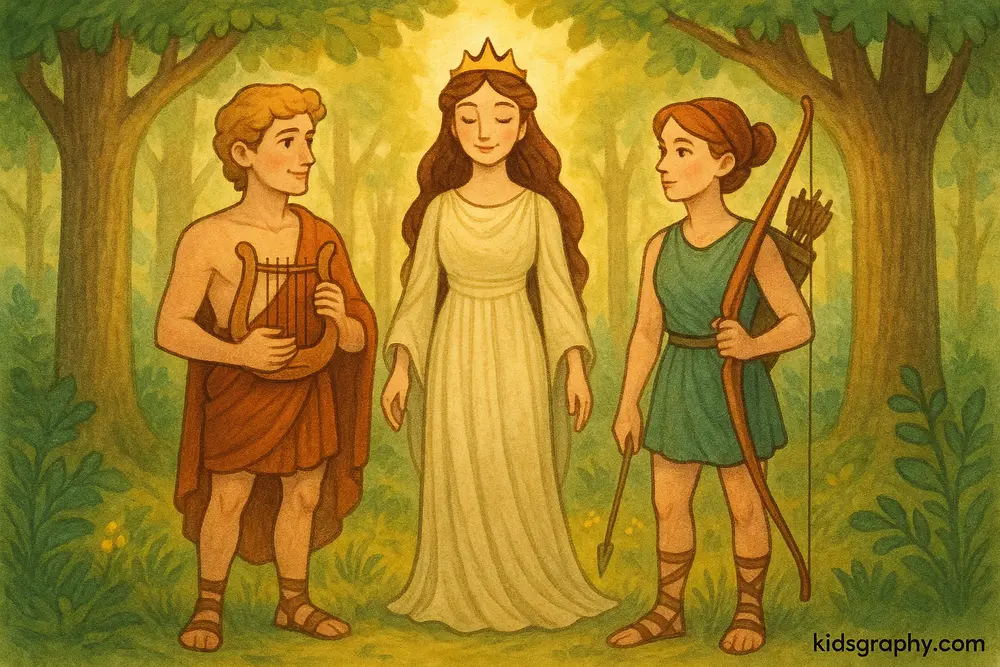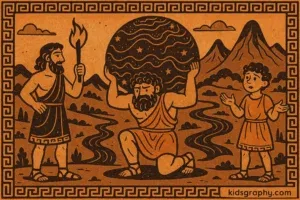In the magical world of Greek mythology, the story of Leto is both gentle and powerful. Though she didn’t wield thunderbolts or rule the seas, Leto played a vital role in the birth of two of the most important Olympian gods: Apollo and Artemis.
Let’s explore the tale of Leto in Greek mythology, her trials, her divine children, and her place among the Titans and gods.
Read More: Hermes in Greek Mythology: Messenger of the Gods
Who Is Leto in Greek Mythology?
Leto is a Titaness, daughter of the Titans Coeus and Phoebe. She is known for being calm, graceful, and patient—very different from many of the louder, more powerful figures in Greek myths.
Although she is not a war goddess or a ruler of Olympus, people honor Leto for being the mother of Apollo and Artemis, two of the most beloved and powerful deities in Greek mythology.
Read More: Pandora in Greek Mythology: The First Woman’s Curse
Zeus and Leto in Greek Mythology
Leto caught the eye of Zeus, king of the gods. The two became lovers, and Leto became pregnant with twins. But when Hera, Zeus’s wife, found out, she was filled with jealousy.
Hera forbade all lands to offer Leto a place to give birth, sending her into a painful and long journey, wandering from place to place while pregnant.
Finally, Leto found refuge on the floating island of Delos, which had not sworn loyalty to Hera. There, she gave birth to her children—first Artemis, and then, with Artemis’s help, Apollo.
Read More: Typhon in Greek Mythology: The Father of Monsters
Leto’s Role as Mother of Artemis and Apollo
Leto is most remembered as the mother of Artemis and Apollo. After their birth, she protected and guided them as they grew into powerful gods.
- Artemis became the goddess of the hunt, wilderness, and moon.
- Apollo became the god of music, healing, the sun, and prophecy.
Leto raised them with love and strength, giving them the tools to become two of Olympus’s most important figures.
She is often shown in ancient art standing beside her children, offering support and wisdom.
Leto’s Powers in Greek Mythology
Unlike gods of war or magic, Leto’s powers were more peaceful and motherly. But that didn’t make her weak.
- She had divine beauty and grace, which attracted Zeus.
- She could soothe pain and offer protection, especially to her children.
- She was also associated with calmness, modesty, and nurturing love.
In some myths, when others mocked or threatened her children, Leto stood her ground. In one tale, she punished the Queen Niobe for insulting her, causing terrible sorrow in return.
Read More: Chaos in Greek Mythology: The First Being of Creation
Facts About Leto in Greek Mythology
- Leto is a Titaness, not an Olympian, yet gave birth to two Olympian gods.
- The island of Delos became a sacred place in her honor.
- She is sometimes worshipped alongside her children in temples.
- Leto represents strength through gentleness in Greek stories.
- The Letoides is a term used to refer to her children together—Apollo and Artemis.
Leto’s Legacy and Worship
Leto may not appear as often as Zeus or Athena in myths, but her legacy lives on through her children and through the values she represents.
She was worshipped in places like Delos and Lycia, where shrines and temples were built for her. People prayed to her for motherhood, protection, and peace.
In ancient art, Leto is shown as tall, calm, and noble, sometimes with a veil and always with her children by her side.
She reminds us that quiet strength can shape destiny, and that love, even in suffering, creates heroes.
Read More: Hera in Greek Mythology: Queen of the Gods
Symbolism of Leto in Greek Mythology
Leto’s character stands out in Greek mythology not because of loud power or grand battles, but because of her inner strength and patience. She symbolizes:
- Motherhood – She endured hardship for her children and raised two of the most important gods.
- Endurance – Leto wandered for days, suffering and rejected, yet never gave up.
- Dignity in silence – She represents the noble strength of those who do not fight with anger, but with calm.
Her presence in myths reminds readers that even the quietest voices can shape the fate of the world.
Artistic Depictions of Leto
Greek artists and sculptors often depict Leto with Artemis and Apollo, sometimes portraying her as she gives birth or holds her infant twins.
- She is depicted as graceful and modest, often with a veil over her head.
- Some ancient vases and carvings show her protecting Apollo from Python, the monstrous serpent he later killed.
In paintings, she often stands or sits beside her children, surrounded by nature—a mother figure rooted in divine peace.
Read More: Cronus in Greek Mythology: Titan of Time and Power
Leto vs. Hera: A Tale of Jealousy and Power
One of the most well-known parts of Leto’s story is her rivalry with Hera, Zeus’s wife. Hera’s anger made Leto an outcast, hunted and rejected during her pregnancy.
This myth shows a strong contrast:
- Hera represents jealousy, wrath, and vengeance.
- Leto represents patience, grace, and gentle strength.
Despite Hera’s efforts, Leto found a way to give birth and protect her children. Her quiet victory is a powerful theme in Greek mythology—kindness and perseverance can outlast cruelty.
Read More: Prometheus in Greek Mythology: The Fire Bringer
Temples and Worship of Leto
Though she was not as widely worshipped as Athena or Demeter, Leto had sacred sites across the ancient world:
- Delos: The island where she gave birth was considered holy. A temple there was dedicated to her and her children.
- Letoon in Lycia (modern-day Turkey): A grand sanctuary complex honoring Leto, Apollo, and Artemis. It is now a UNESCO World Heritage site.
- Crete, Delphi, and Delos all had altars and festivals for her family.
Leto’s followers prayed for safe childbirth, protection for children, and divine calm in times of stress.
More Stories: Leto in Greek Mythology
FAQ: Leto in Greek Mythology
Leto is a Titaness and the mother of Apollo and Artemis. She is known for her grace, patience, and divine motherhood.
People remember Leto most for giving birth to the twin gods Apollo and Artemis on the island of Delos, after Hera’s jealousy forced her into a long exile.
Leto had powers linked to protection, motherhood, and serenity. She was known for her calming presence and divine beauty.
Hera, Zeus’s wife, was jealous of Leto’s pregnancy by Zeus and banned all lands from sheltering her, forcing Leto to wander while pregnant.
People worshipped Leto on Delos and at the sanctuary of Letoon in Lycia, where they built temples in her honor alongside Apollo and Artemis.
Read More: Athena in Greek Mythology: Goddess of Wisdom & War











